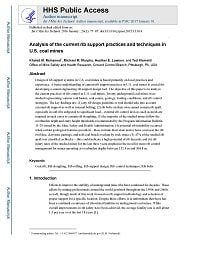Mining Publication: Analysis of the Current Rib Support Practices and Techniques in U.S. Coal Mines
Original creation date: January 2016
Authors: KM Mohamed, MM Murphy, HE Lawson, TM Klemetti
Design of rib support systems in U.S. coal mines is based primarily on local practices and experience. A better understanding of current rib support practices in U.S. coal mines is crucial for developing a sound engineering rib support design tool. The objective of this paper is to analyze the current practices of rib control in U.S. coal mines. Twenty underground coal mines were studied representing various coal basins, coal seams, geology, loading conditions, and rib control strategies. The key findings are: (1) any rib design guideline or tool should take into account external rib support as well as internal bolting; (2) rib bolts on their own cannot contain rib spall, especially in soft ribs subjected to significant load—external rib control devices such as mesh are required in such cases to contain rib sloughing; (3) the majority of the studied mines follow the overburden depth and entry height thresholds recommended by the Program Information Bulletin 11-29 issued by the Mine Safety and Health Administration; (4) potential rib instability occurred when certain geological features prevailed—these include draw slate and/or bone coal near the rib/roof line, claystone partings, and soft coal bench overlain by rock strata; (5) 47% of the studied rib spall was classified as blocky—this could indicate a high potential of rib hazards; and (6) rib injury rates of the studied mines for the last three years emphasize the need for more rib control management for mines operating at overburden depths between 152.4 m and 304.8 m.

- Diagnosing and Controlling Moisture-Sensitive Roof in Coal Mines
- Effect of the Dip and Excavation Orientation on Roof Stability in Moderately Dipping Stone Mine Workings
- Optimizing Secondary Roof Support with the NIOSH Support Technology Optimization Program (STOP)
- Overview of Coal Mine Ground Control Issues in the Illinois Basin
- Pillar and Roof Span Design Guidelines for Underground Stone Mines
- Preventing Falls of Ground in Coal Mines With Exceptionally Low-Strength Roof: Two Case Studies
- Pumpable Roof Supports: Developing Design Criteria by Measurement of the Ground Reaction Curve
- Technology News 482 - Ground Support Safety Training Video
- Tests of Fibre-Reinforced Shotcrete at the Chief Joseph Mine, Butte, Montana
- Updating the NIOSH Support Technology Optimization Program (STOP) With New Support Technologies and Additional Design Features